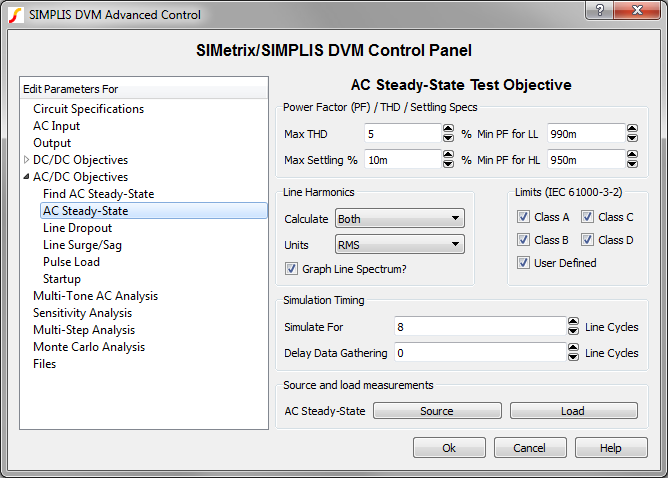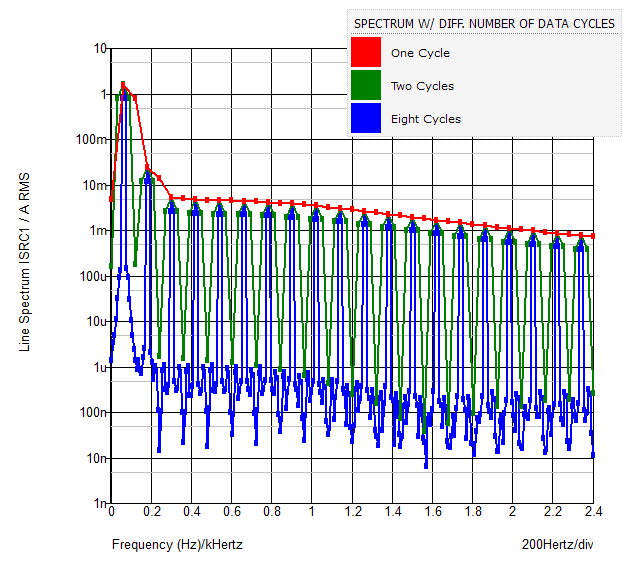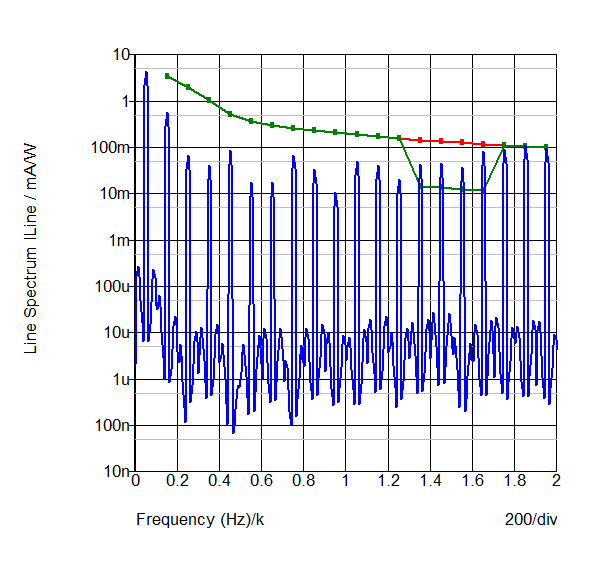DVM - Design Verification Module
|
This topic describes how the spectral content of the AC input source is calculated and how those results are affected by the simulation timing parameters. Additionally, you can customize harmonic limits used for specification checking.
In this Topic Hide
After every ACSteadyState test, DVM can measure, plot, and compare results to specifications for the first 40 harmonics of each DVM input source. From the AC Steady-State page in the DVM control symbol dialog box, you select the operations to perform.

This configuration is flexible, allowing you to individually select operations that customize the test-report format from the dialog above. You can select any or all of the following:
The Fast Fourier Transform (FFT) method is used to calculate the harmonic content of the input source supplied as an argument to the ACSteadyState() test objective. The FFT returns results which are a close approximation of harmonic content without the time-consuming continuous Fourier method. The FFT algorithm used by DVM uses a 'Hanning' window and a 2nd-order interpolation. For most offline converters with a line filter, this algorithm produces reliable results. The intricacies of the FFT algorithm can fill volumes and are, therefore, not detailed here.
You define the simulation start and stop times for the ACSteadyState() test objectives from the Simulation Timing section of the DVM control symbol.
The number of line cycles simulated affects the appearance (but not the accuracy at the harmonic frequencies) of the Spectrum plot. The default simulation times are as follows:
These default values give 8 line cycles of data for the FFT algorithm
to calculate the spectrum. The Fourier resolution is determined directly
by the number of line cycles:
\[ \text{Fres} = \frac{\text{Frequency}}{\text{NCycles}} \]
With the default NCycles = 8, this produces a reasonably detailed spectrum while minimizing the simulation time required.
Be aware that a trade off exists between the time required to simulate the converter and the resolution of the FFT spectrum. This is best visualized with the FFT Spectrum plot below which is taken from simulation runs with 1, 2, and 8 line cycles:

Two conclusions are reached from this plot:
The accuracy of the odd-order harmonics is largely unaffected by the number of line cycles present in the simulation data.
The even-number harmonics (including DC) are over-represented in the FFT plot when the number of line cycles is low. Since the reported scalar values are taken from the plotted data, accuracy of even-order harmonics can be guaranteed only if more than one line cycle is simulated.
Finally, in order to have accurate results from the FFT, the circuit must be completely settled. Usually this is accomplished through the IncludeInitFile column, which uses a SIMPLIS .init file generated in an earlier test run. If, however, that file is inaccurate or if the circuit requires some time to settle, you can edit the Simulation Timing parameters on the DVM control symbol and increase the number of cycles in the Delay Data Gathering field and increase the Simulate parameter, which yields good harmonic spectrum results.
The specifications for each IEC61000-3-2 harmonic limit class (Class A, Class B, etc.) as well as any user defined limits are stored in a tab-separated file named harmonic_specs.def. The master version of this file is included in the support\dvm folder of your SIMetrix/SIMPLIS installation directory.
After running your first ACSteadyState() simulation, DVM copies this file from the installation directory to your schematic's working directory, assuming that the file does not already exist. This local file then becomes the source for all harmonic limits for schematics run from that directory.
Alternately, you can add a property to the DVM control symbol that specifies a full file path and name. To add this property, do the following:
After you add this property, the specification file will be sourced from the path defined by the property value. Using the full path and filename is mandatory.
Each column of the harmonic specification file contains the information
required to define a complete set of harmonic limits with following format:
Follow these rules to obtain the proper syntax:
For example, if you change the Display Name to "my limits1" in the second column where it was "Class A Harmonic Limits," the checkbox for Class A in the dialog box will still have the label, "Class A". The actual harmonic limit values are always taken from the harmonic specs table.
Being able to change the limits can be useful; for example, if the converter under test draws more than 16A per phase and the harmonic limits for IEC 61000-3-12 need to be checked, you need to enter only the values in the table; and DVM will use those values for specification checking and determine the PASS/FAIL status accordingly.
The first set of user-defined limits is entered in the 6th column. Since the columns are tab separated, editing with a spreadsheet program is recommended. User-defined limits can have any of the three units (A_RMS, %_Fundamental, mA/W) and are both plotted and checked against measured values if User Defined is checked in the DVM control symbol dialog. Note that all user limits, from the 6th column to the right-most column, are verified if "User Defined" is checked.
The user-defined limits from the harmonic specs file will be plotted on graphs with the appropriate units. If you check User Defined in the DVM control symbol dialog, multiple graphs will be plotted. For example, if there are two user-defined limit columns with units A_RMS and mA/W, two spectrum graphs will be generated in the test report with one for each unit. Additionally, if the IEC limit is checked and that limit has the same units as the user-defined limits, both limit curves will be plotted on the same spectrum graph. This allows you to easily see how the user-defined limits compare to the IEC limits.
You can download a copy of a user-configured harmonic specs file here: harmonics_specs.def. This file is also shown in the table below:
| Harm# | Class A Harmonic Limits | Class B Harmonic Limits | Class C Harmonic Limits | Class D Harmonic Limits | User Notch Limits |
| *** | A_RMS | A_RMS | %_Fundamental | mA/W | mA/W |
| 0 | -1 | -1 | -1 | -1 | -1 |
| 1 | -1 | -1 | -1 | -1 | -1 |
| 2 | 1.08 | 1.62 | 0.02 | -1 | -1 |
| 3 | 2.3 | 3.45 | 0.3 | 3.4 | 3.4 |
| 4 | 0.43 | 0.645 | -1 | -1 | -1 |
| 5 | 1.4 | 1.71 | 0.1 | 1.9 | 1.9 |
| 6 | 0.3 | 0.45 | -1 | -1 | -1 |
| 7 | 0.77 | 1.155 | 0.07 | 1 | 1 |
| 8 | 0.23 | 0.345 | -1 | -1 | -1 |
| 9 | 0.4 | 0.6 | 0.05 | 0.5 | 0.5 |
| 10 | 0.184 | 0.276 | -1 | -1 | -1 |
| 11 | 0.33 | 0.495 | 0.03 | 0.35 | 0.35 |
| 12 | 0.153333333 | 0.23 | -1 | -1 | -1 |
| 13 | 0.21 | 0.315 | 0.03 | 0.296153846 | 0.296153846 |
| 14 | 0.131428571 | 0.197142857 | -1 | -1 | -1 |
| 15 | 0.15 | 0.225 | 0.03 | 0.256666667 | 0.256666667 |
| 16 | 0.115 | 0.1725 | -1 | -1 | -1 |
| 17 | 0.132352941 | 0.198529412 | 0.03 | 0.226470588 | 0.226470588 |
| 18 | 0.102222222 | 0.153333333 | -1 | -1 | -1 |
| 19 | 0.118421053 | 0.177631579 | 0.03 | 0.202631579 | 0.202631579 |
| 20 | 0.092 | 0.138 | -1 | -1 | -1 |
| 21 | 0.107142857 | 0.160714286 | 0.03 | 0.183333333 | 0.183333333 |
| 22 | 0.083636364 | 0.125454545 | -1 | -1 | -1 |
| 23 | 0.097826087 | 0.14673913 | 0.03 | 0.167391304 | 0.167391304 |
| 24 | 0.076666667 | 0.115 | -1 | -1 | -1 |
| 25 | 0.09 | 0.135 | 0.03 | 0.154 | 0.154 |
| 26 | 0.070769231 | 0.106153846 | -1 | -1 | -1 |
| 27 | 0.083333333 | 0.125 | 0.03 | 0.142592593 | 0.014259259 |
| 28 | 0.065714286 | 0.098571429 | -1 | -1 | -1 |
| 29 | 0.077586207 | 0.11637931 | 0.03 | 0.132758621 | 0.013275862 |
| 30 | 0.061333333 | 0.092 | -1 | -1 | -1 |
| 31 | 0.072580645 | 0.108870968 | 0.03 | 0.124193548 | 0.012419355 |
| 32 | 0.0575 | 0.08625 | -1 | -1 | -1 |
| 33 | 0.068181818 | 0.102272727 | 0.03 | 0.116666667 | 0.011666667 |
| 34 | 0.054117647 | 0.081176471 | -1 | -1 | -1 |
| 35 | 0.064285714 | 0.096428571 | 0.03 | 0.11 | 0.11 |
| 36 | 0.051111111 | 0.076666667 | -1 | -1 | -1 |
| 37 | 0.060810811 | 0.091216216 | 0.03 | 0.104054054 | 0.104054054 |
| 38 | 0.048421053 | 0.072631579 | -1 | -1 | -1 |
| 39 | 0.057692308 | 0.086538462 | 0.03 | 0.098717949 | 0.098717949 |
| 40 | 0.046 | 0.069 | -1 | -1 | -1 |
In this example, the a 6th column provides the name User Notch Limits, which have the units of mA/W. The limits from the Class D limit column were copied and the limits for the 27th, 29th, 31st and 33rd harmonics were decreased by 20dB. This notch is present on the output graph from this simulation. The red curve is the Class D limit, and the green curve is the User Notch Limits:

© 2015 simplistechnologies.com | All Rights Reserved